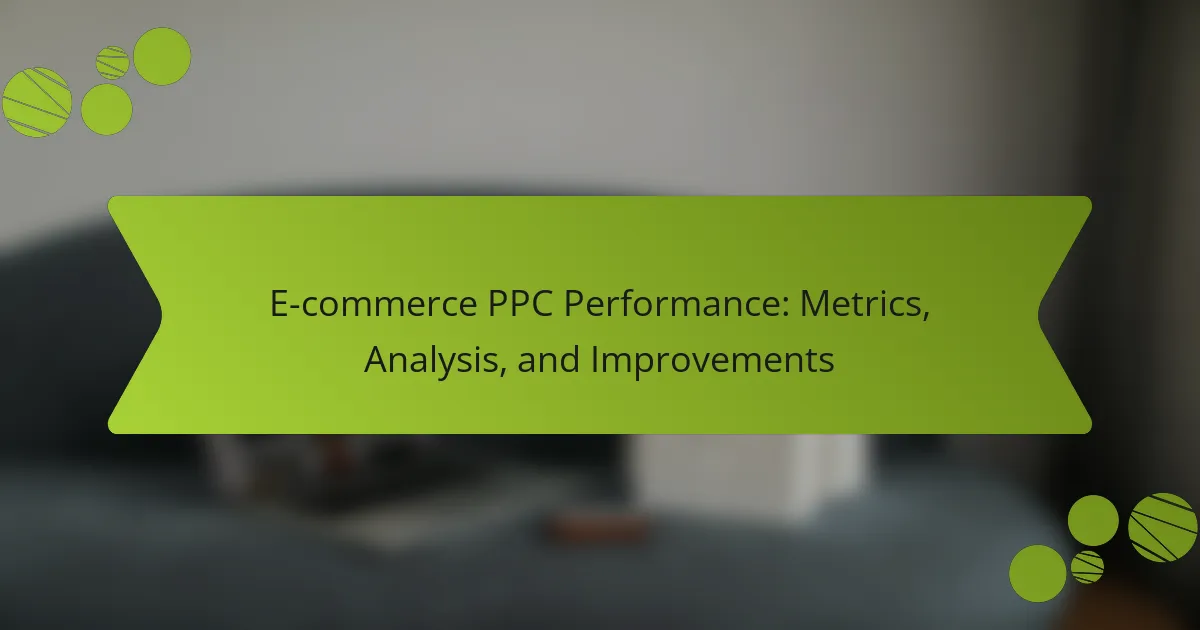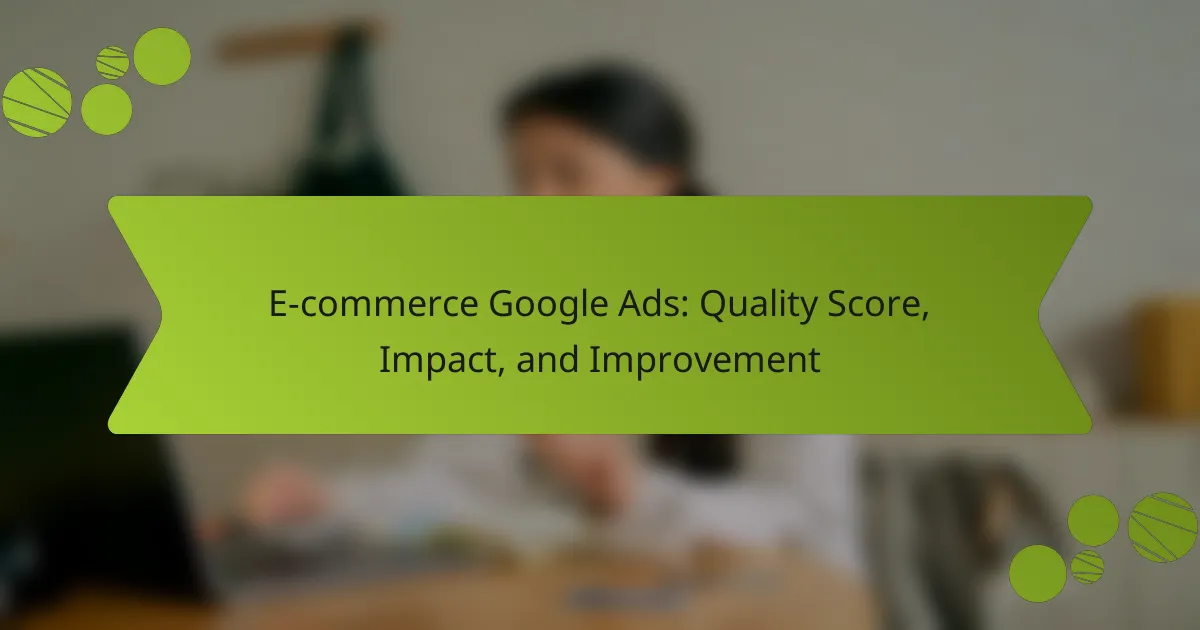In the competitive landscape of e-commerce, optimizing PPC performance is crucial for driving qualified traffic and maximizing returns. By focusing on key metrics such as click-through rate, conversion rate, and cost per acquisition, businesses can gain valuable insights into their campaigns. Additionally, leveraging audience segmentation allows for tailored advertising strategies that enhance engagement and boost conversion rates.
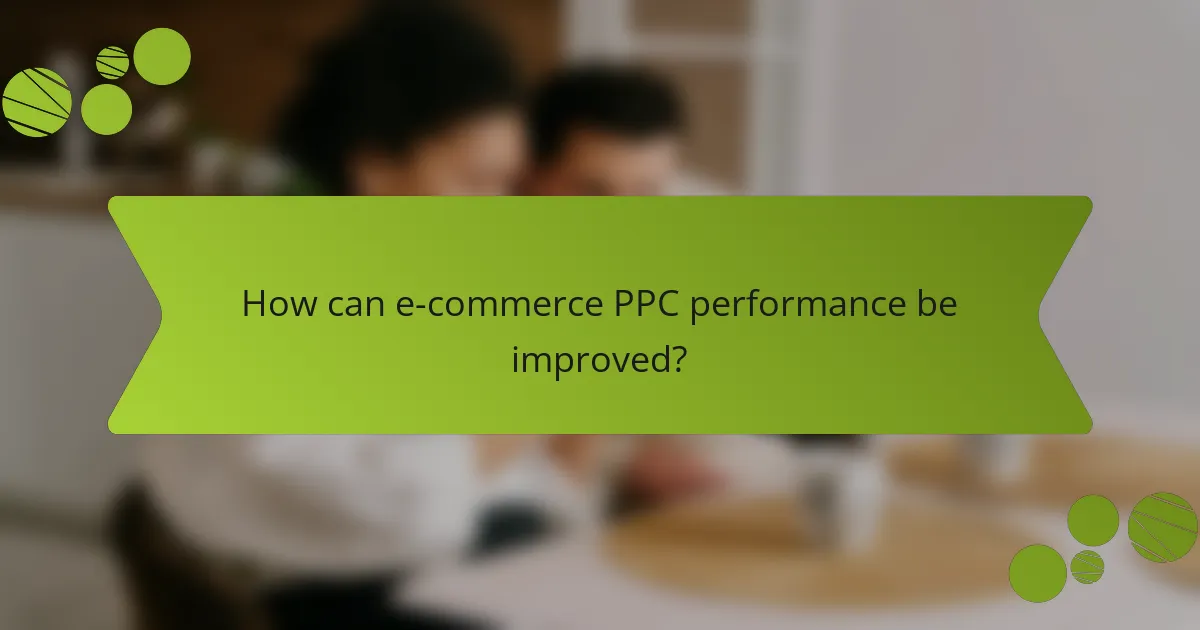
How can e-commerce PPC performance be improved?
Improving e-commerce PPC performance involves refining strategies across various aspects, including targeting, ad copy, and bidding. By focusing on these key areas, businesses can enhance their return on investment and drive more qualified traffic to their online stores.
Optimize ad targeting
Ad targeting is crucial for reaching the right audience. Utilize demographic data, interests, and behaviors to create specific audience segments. This ensures that your ads are shown to users who are more likely to convert, improving overall campaign effectiveness.
Consider using tools like Google Ads’ audience insights to refine your targeting. Regularly review performance metrics to adjust your audience segments based on engagement and conversion rates.
Enhance ad copy
Compelling ad copy can significantly impact click-through rates and conversions. Focus on clear, concise messaging that highlights the unique selling points of your products. Use strong calls to action to encourage users to take the next step.
Incorporate keywords relevant to your audience’s search intent, but avoid keyword stuffing. A/B testing different headlines and descriptions can help identify which variations resonate best with your target market.
Utilize A/B testing
A/B testing allows you to compare different versions of your ads to determine which performs better. Test elements such as headlines, images, and calls to action to gather data on user preferences. This iterative process helps refine your campaigns for optimal performance.
Start with small changes and track results over time. Aim for statistically significant data before making broad changes based on test outcomes.
Adjust bidding strategies
Effective bidding strategies can maximize your ad spend and improve visibility. Consider using automated bidding options that adjust bids based on performance metrics, or set manual bids based on your budget and goals.
Monitor your cost-per-click (CPC) and return on ad spend (ROAS) regularly. Adjust bids for high-performing keywords while reducing spend on underperforming ones to optimize your budget allocation.
Implement retargeting campaigns
Retargeting campaigns are essential for re-engaging users who have previously interacted with your site. By showing ads to these potential customers, you can remind them of products they viewed and encourage them to complete their purchases.
Utilize platforms like Google Ads and Facebook Ads to set up retargeting lists. Tailor your messaging based on user behavior, such as showing specific products they viewed or offering discounts to incentivize conversions.
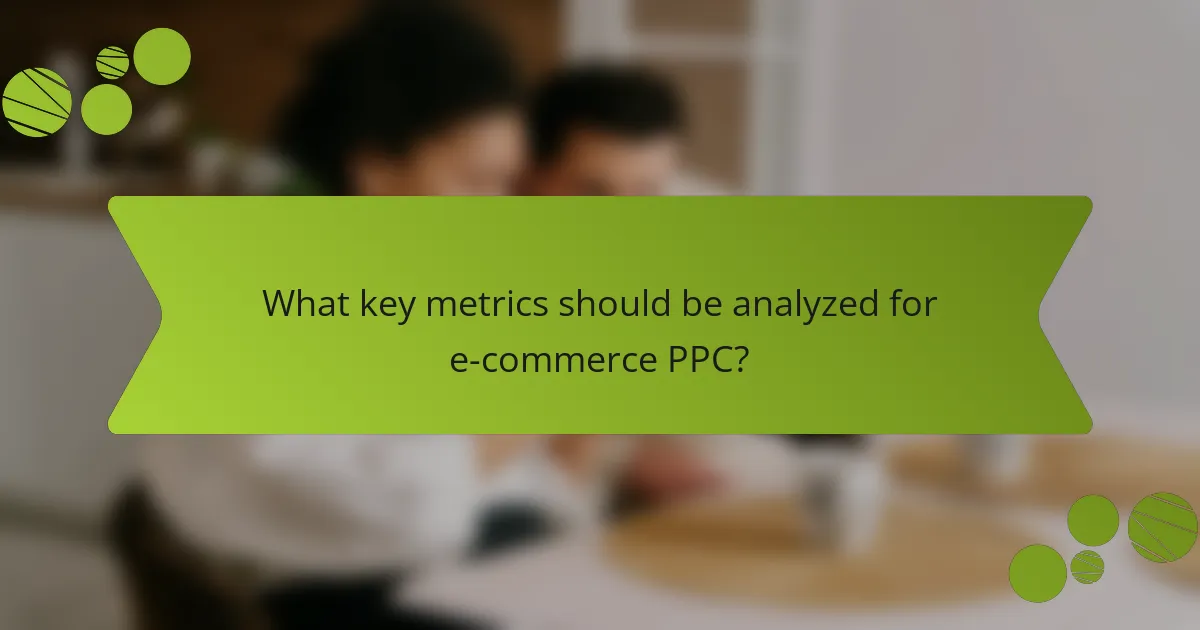
What key metrics should be analyzed for e-commerce PPC?
Key metrics for analyzing e-commerce PPC include click-through rate (CTR), conversion rate, cost per acquisition (CPA), and return on ad spend (ROAS). These metrics help evaluate the effectiveness of your campaigns, guiding adjustments to improve performance and maximize profitability.
Click-through rate (CTR)
Click-through rate (CTR) measures the percentage of users who click on your ad after seeing it. A higher CTR indicates that your ad is relevant and engaging to your target audience. Aim for a CTR of around 2-5% for e-commerce campaigns, but this can vary by industry.
To improve CTR, focus on crafting compelling ad copy and using eye-catching visuals. Regularly test different headlines and calls to action to see what resonates best with your audience.
Conversion rate
Conversion rate is the percentage of users who complete a desired action, such as making a purchase, after clicking on your ad. A typical conversion rate for e-commerce sites ranges from 1-3%, depending on the industry and product type. Analyzing this metric helps identify the effectiveness of your landing pages and overall user experience.
To enhance conversion rates, ensure your landing pages are optimized for speed and mobile-friendliness. Implement clear calls to action and reduce any friction in the checkout process to encourage purchases.
Cost per acquisition (CPA)
Cost per acquisition (CPA) indicates how much you spend to acquire a customer through your PPC campaigns. A lower CPA is generally better, as it means you are spending less to gain each customer. Aim for a CPA that aligns with your profit margins to ensure sustainability.
To manage CPA effectively, monitor your ad spend closely and adjust bids based on performance. Consider using negative keywords to filter out unqualified traffic, which can help lower your acquisition costs.
Return on ad spend (ROAS)
Return on ad spend (ROAS) measures the revenue generated for every dollar spent on advertising. A ROAS of at least 4:1 is often considered a good benchmark for e-commerce, meaning for every dollar spent, you earn four in return. This metric is crucial for assessing the profitability of your PPC campaigns.
To improve ROAS, analyze which campaigns and keywords yield the highest returns and allocate more budget to those areas. Regularly review and optimize underperforming ads to enhance overall campaign profitability.
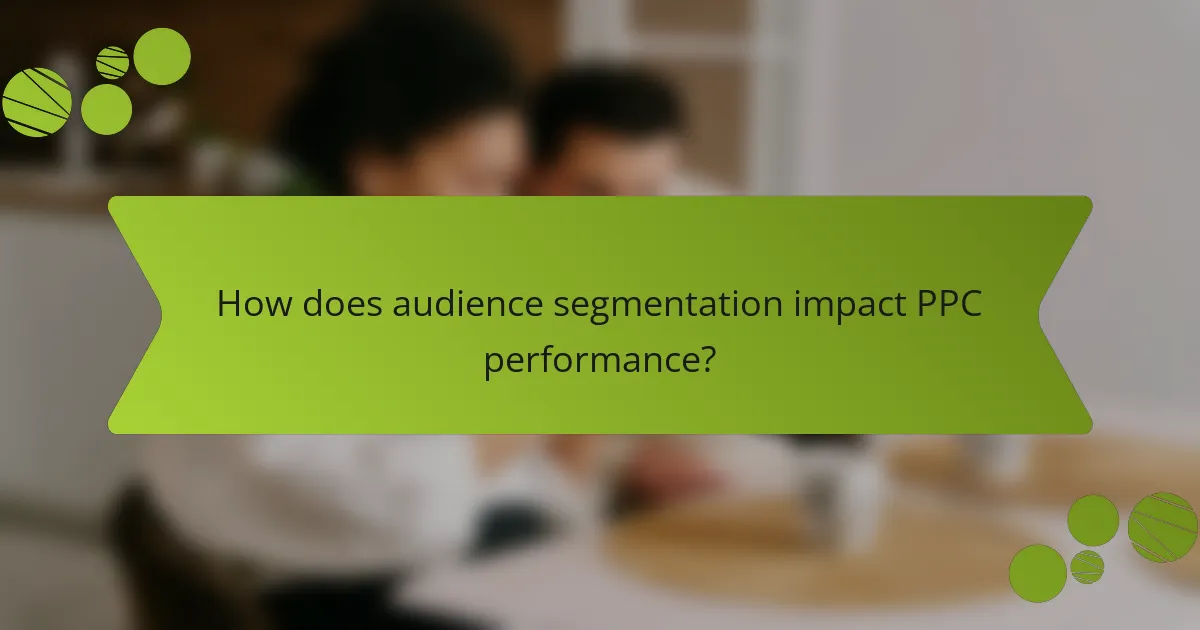
How does audience segmentation impact PPC performance?
Audience segmentation significantly enhances PPC performance by allowing advertisers to tailor their campaigns to specific groups. This targeted approach leads to more relevant ads, which can improve engagement and conversion rates.
Improved targeting accuracy
Improved targeting accuracy is a direct benefit of audience segmentation in PPC campaigns. By dividing the audience into distinct segments based on demographics, interests, or behaviors, advertisers can create ads that resonate more with each group. For instance, a sports apparel brand might target younger audiences with trendy styles while promoting classic designs to older customers.
To achieve better targeting, utilize data analytics tools to identify key characteristics of your audience segments. Regularly review and adjust your segmentation criteria based on performance metrics to ensure ongoing relevance.
Higher engagement rates
Higher engagement rates often result from well-segmented PPC campaigns. When ads are tailored to specific audience segments, they are more likely to capture attention and encourage interaction. For example, personalized messaging that speaks directly to a segment’s needs can lead to increased click-through rates.
To boost engagement, consider A/B testing different ad variations for each segment. This approach helps identify which messages resonate best and allows for continuous optimization of ad content.
Increased ROI
Increased ROI is a key outcome of effective audience segmentation in PPC advertising. By targeting the right audience with relevant ads, businesses can reduce wasted ad spend and improve conversion rates. For instance, a campaign focused on high-intent buyers may yield a significantly higher return compared to a broad, untargeted approach.
To maximize ROI, track performance metrics such as cost per acquisition (CPA) and conversion rates for each segment. Adjust budgets to allocate more resources to the highest-performing segments, ensuring that your advertising spend is optimized for the best results.
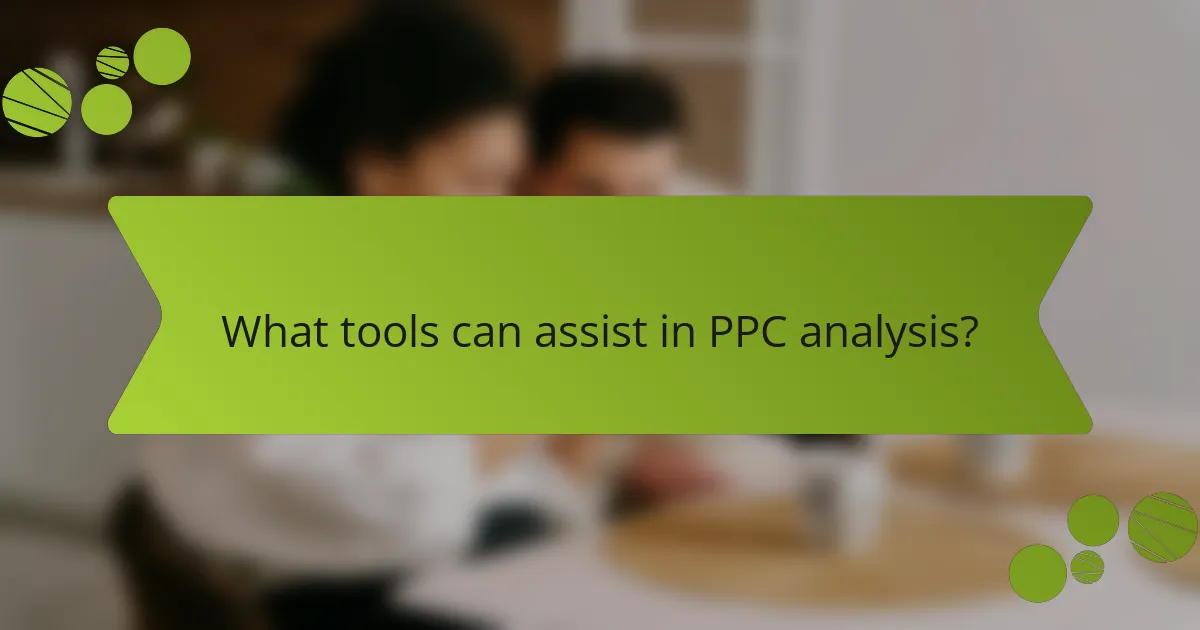
What tools can assist in PPC analysis?
Several tools can enhance PPC analysis by providing insights into campaign performance, keyword effectiveness, and competitive positioning. Utilizing these tools can help optimize ad spend and improve overall return on investment.
Google Ads
Google Ads is a primary platform for managing PPC campaigns, offering robust analytics features. It allows users to track metrics such as click-through rates (CTR), conversion rates, and cost per acquisition (CPA), which are essential for evaluating ad performance.
To maximize the effectiveness of Google Ads, regularly review your Quality Score, which impacts ad placement and cost. Utilize A/B testing for ad variations to determine what resonates best with your target audience.
SEMrush
SEMrush provides comprehensive tools for PPC analysis, including keyword research and competitive analysis. It allows users to identify high-performing keywords and analyze competitors’ ad strategies, which can inform your own campaigns.
When using SEMrush, focus on the PPC Keyword Tool to discover new keyword opportunities and the Ad Builder to create compelling ad copy. Regularly monitor the PPC Analytics section to assess your campaign’s effectiveness compared to industry benchmarks.
Ahrefs
Ahrefs is primarily known for SEO, but it also offers valuable insights for PPC campaigns. Its tools can help analyze competitor ads and keywords, providing a broader understanding of the market landscape.
Utilize Ahrefs’ Site Explorer to examine the paid traffic of competitors and identify which keywords drive their success. This information can guide your keyword selection and bidding strategies, ensuring you remain competitive in your niche.

What are common pitfalls in e-commerce PPC campaigns?
Common pitfalls in e-commerce PPC campaigns include poor keyword selection, inadequate budget management, and neglecting ad performance analysis. These issues can lead to wasted spending and missed opportunities for conversions.
Poor Keyword Selection
Choosing the wrong keywords can severely impact the effectiveness of your PPC campaigns. Focusing on overly broad or irrelevant keywords may attract traffic that does not convert, while overly specific keywords might limit your reach. Aim for a balanced mix of broad, phrase, and exact match keywords to optimize visibility and relevance.
Regularly review and refine your keyword list based on performance data. Utilize tools like Google Ads Keyword Planner to identify high-volume, relevant keywords that align with your products. Consider long-tail keywords as they often have lower competition and higher conversion rates.
Inadequate Budget Management
Budget mismanagement can lead to either overspending or underutilizing your ad potential. Setting a daily budget that is too low may prevent your ads from being shown, while an excessively high budget without proper tracking can drain resources quickly. Establish a budget that aligns with your business goals and monitor it closely.
Implement bid strategies that maximize your return on investment (ROI). Consider using automated bidding options available in platforms like Google Ads, which can help optimize your spending based on performance data. Regularly assess your budget allocation across campaigns to ensure funds are directed toward the most effective ads.
Neglecting Ad Performance Analysis
Failing to analyze ad performance can result in missed insights and opportunities for improvement. Regularly reviewing metrics such as click-through rates (CTR), conversion rates, and cost per acquisition (CPA) is essential for understanding what works and what doesn’t. Set up regular reporting to track these metrics over time.
Utilize A/B testing to compare different ad variations and determine which elements drive better performance. Adjust your campaigns based on data-driven insights, and don’t hesitate to pause or modify underperforming ads. This proactive approach can significantly enhance your PPC outcomes.





